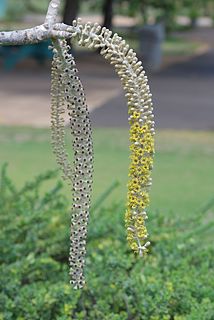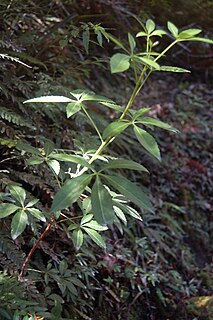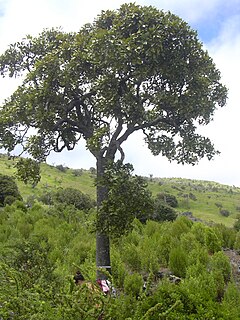
The Araliaceae is a family of flowering plants composed of about 43 genera and approximately 1500 species consisting of primarily woody plants and some herbaceous plants. The morphology of Araliaceae varies widely, but it is predominantly distinguishable based on its woody habit, tropical distribution, and the presence of simple umbels.

Aralia, or spikenard, is a genus of the family Araliaceae, consisting of 68 accepted species of deciduous or evergreen trees, shrubs, and rhizomatous herbaceous perennials. The genus is native to Asia and the Americas, with most species occurring in mountain woodlands. Aralia plants vary in size, with some herbaceous species only reaching 50 centimetres (20 in) tall, while some are trees growing to 20 metres (66 ft) tall.

Hedera, commonly called ivy, is a genus of 12–15 species of evergreen climbing or ground-creeping woody plants in the family Araliaceae, native to western, central and southern Europe, Macaronesia, northwestern Africa and across central-southern Asia east to Japan and Taiwan.

The Panax (ginseng) genus belongs to the Araliaceae (ivy) family. Panax species are characterized by the presence of ginsenosides and gintonin. Panax is one of approximately 60 plant genera with a classical disjunct east Asian and east North American distribution. Furthermore, this disjunct distribution is asymmetric as only two of the ~18 species in genus are native to North America.

GastoniaCommerson ex Lamarck is a formerly accepted genus of flowering plants in the ivy and ginseng family, Araliaceae. It had been known as an unnatural group, but was recognized as late as 2010, when its nine species were distributed to four different subgenera of the large genus Polyscias. Because the genus Gastonia is now obsolete, its species are herein referred to by their names in Polyscias.

Schefflera is a genus of flowering plants in the family Araliaceae. With an estimated 600–900 species, the genus represents about half of its family. The plants are trees, shrubs or lianas, growing 4–20 metres (13–66 ft) tall, with woody stems, the absence of articulated pedicels and armaments, and palmately compound leaves.

Polyscias racemosa, or false 'ohe, is a species of flowering plant in the family Araliaceae. As Munroidendron racemosum, the species was until recently considered to be the only species in the monotypic genus Munroidendron. With the change in classification, Munroidendron is now obsolete. Polyscias racemosa is endemic to the Hawaiian island of Kauai. It is very rare in the wild and some of its original habitat has been replaced by sugar cane plantations. It was thought for some time to be probably extinct, but was rediscovered a few years prior to 1967.

Meryta is a genus in the flowering plant family Araliaceae. There are 28 described species in the genus and a number of undescribed species, all small, resinous trees of the subtropical and tropical Pacific Ocean, characterized by huge, simple leaves and a dioecious sexual system, a unique combination in Araliaceae. Meryta has its center of diversity in New Caledonia. Phylogenetic analyses have placed Meryta as a monophyletic genus in one of the three major clades of the Araliaciae, the Polyscias-Pseudopanax group, and more specifically in the Pacific Schefflera subclade.
Arthrophyllum is a defunct genus of flowering plants in the family Araliaceae. It was recognized by most authors until 2010, when all of its 30 species were "sunk" into ''Polyscias'' subgenus Arthrophyllum.

Cheirodendron is a genus of flowering plant in the family Araliaceae. All six species in the genus are endemic to Polynesia. The five Hawaiian species are generally called ʻōlapa, and occur in wet forests on all major islands as well as some mesic forests, such as Kipuka Puaulu.
Cuphocarpus is an obsolete genus of flowering plants in the family Araliaceae. Mabberley (2008) treated it as a synonym of Polyscias, but other authors still recognized it at that time. In 2010, in a phylogenetic analysis of DNA sequences, it was shown that Cuphocarpus was biphyletic and embedded in the large genus Polyscias. In an accompanying paper, Polyscias was divided into 11 subgenera, with seven species left incertae sedis.

Polyscias is a genus of flowering plants in the family Araliaceae. They bear pinnately compound leaves.

Raukaua is a genus of flowering plants in the family Araliaceae. It has an austral distribution, being indigenous to southern Argentina and Chile, as well as New Zealand and the island of Tasmania.

Reynoldsia is an obsolete genus of flowering plants in the ivy family, Araliaceae. In 2003, Kew Gardens published a checklist for Araliaceae, in which eight species were recognized for Reynoldsia: four from Samoa, two from Tahiti, one from the Marquesas, and one from Hawaii. In 2010, a phylogenetic comparison of DNA data showed that Reynoldsia was polyphyletic, consisting of two groups that are not each other's closest relatives. In a companion paper, three of the species were "sunk" into synonymy with others, reducing the number of species to five. All species that were formerly in Reynoldsia are now in ''Polyscias'' subgenus Tetraplasandra, a subgenus of 21 species indigenous to Malesia and Pacific islands.

Tetraplasandra is an obsolete genus of flowering plants in the ivy family, Araliaceae. They are small to medium trees, of mesic to wet forests.
Paleopanax is an extinct genus of flowering plant in the Ginseng family, Araliaceae, containing the single species Paleopanax oregonensis. The species is solely known from the middle Eocene sediments exposed in north central Oregon and was first described from a series of isolated fossil fruits in siltstones.

Schubertia is a genus of flowering plants in the family Apocynaceae, first described as a genus in 1810. It is native to South America.

Chengiopanax sciadophylloides is a flowering tree in the family Araliaceae native to Japan. Previously included in the genus Eleutherococcus, it is distinguished from other members of that genus by not having spines or prickles and ITS sequence data confirmed the separation.

Trevesia palmata is a flowering plant in the family Araliaceae that is found in southeast Asia

Trevesia burckii is a flowering plant in the family Araliaceae found from Sumatra to Borneo
















